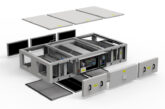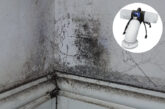
Nuaire has supplied Boxer Bespoke Air Handling Units (AHU) and award winning XBC Heat Recovery Units to the University Arms Hotel for a major redevelopment project.
The University Arms Hotel in Cambridge first opened its doors in 1834 as the city’s first hotel. The Hotel has now reopened after an £80m transformation, which combined a complex heat recovery retrofit with a sympathetic restoration scheme.
Retrofitting a full heat recovery system presented a complex range of challenges, as Nuaire’s regional Sales Engineer Andrew Bott explains: “Getting ductwork to 192 bedrooms through limited ceiling voids across levels that do not line up laterally, and down risers that did not stack vertically was complicated enough but when considered alongside the VRV refrigerant pipework to 192 fan coil units and the usual water system pipework made the difficult seem impossible.” Furthermore, due to planning restrictions the available roof space was constrained to a small plant area above the new build section which was also limited in height so as not to be visible.
John Slater and Haward consultant, Colin Bowen decided to opt for a central plant solution, and turned to Nuaire for help to design the AHUs. Colin explained: “Nuaire were the obvious choice due to their flexible Boxer Bespoke AHU solution and their experience working with complex projects such as this.”
Nuaire delivered two bespoke AHUs serving a total of 4.4m3/s of fresh filtered air to the bedrooms which were split west and east. Thermal wheels were used to provide the heat recovery mechanism and purge sectors were applied to prevent cross contamination of exhaust air onto the supply. The design team at Nuaire were able to work in millimetre intervals to squeeze the maximum air volume out of each AHU, the largest of which has a supply and extract rate of 2.9m3/s with a unit height of just 2,222 mm.
John Slater and Haward designed an innovative ductwork solution to avoid “crossovers”, protecting the corridor ceiling heights; an architecturally stunning feature. Splitting the supply air into two smaller ducts running either side of a larger central extract duct allowed the extract connections to pass over the supply and the need to cross large ducts was eliminated. This simple innovation unlocked so many of the other engineering challenges allowing the design team to think laterally. By separating ventilation ducts and other services onto alternating floors, space was created for the water pipes and refrigerant connections. A void containing AC pipes and wet services on one floor serving “above and below” meant that the next floor up had a free void for ventilation ducts again serving the upper and lower levels. This pattern was repeated on the next two stories creating alternate layers of vent ducts or pipes.
The last remaining challenge with any central plant solution, especially one as complicated as this, is how to route and conceal the large distribution ducts serving the many risers. The radical decision was taken to raise the existing roof level to the highly sensitive Parkers Piece elevation to accommodate the lateral run. This brave architectural move coupled with Nuaire’s compact unit design, proved to be an immense success, concealing all plant services from sight and preserving the stunning visual detail of the eastern façade.
Nuaire’s award winning XBC heat recovery units were selected to serve the other public spaces including the striking library and bar areas, ensuring that energy efficiency was protected throughout the building. The XBC’s success as a low breakout noise solution safeguarded the acoustically sensitive bedrooms located near to the light-wells in which they were installed. Here, Ecosmart controls were deployed throughout to ensure the lowest possible energy consumption by linking air volumes directly to occupancy or indoor air quality demands. The designers turned to the SQUIF and Airmover Range of extract fans to serve the main and finishing kitchen areas, utilizing their ability to be vertically mounted to conceal them in a faux chimney stack, constructed up through the light-well terminating in roof level vents disguised as chimney pots.
Nuaire provides a full range of energy-efficient domestic, commercial and renewable ventilation solutions. UK based with over 500 employees worldwide, Nuaire has been at the forefront of the ventilation industry since 1966.
For more information please visit www.nuaire.co.uk








